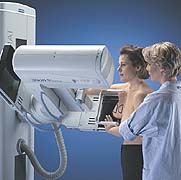Preparation for mammography requires a few simple steps from the patient and mostly requires good communication with the technologist who will perform the mammogram and a good knowledge of your previous mammogram history. Many locations may ask you to provide the information found in this sample pre-mammography questionnaire.

The technologist positions the patient for a medio lateral oblique (MLO) view
- To help minimize discomfort during mammography, schedule your mammogram to take place one week after your period (when breasts are less tender).
- If possible, bring your previous mammogram with you, or bring a list of where and when you have had previous mammograms with you to your appointment.
- On the day of the examination, do not wear talcum powder, deodorant, lotion or perfume under your arms or on your breasts. These substances can cause artifacts on your mammogram making the images harder to interpret (aluminum flecks in some powders and deodorants can mimic microcalcifications on the x-ray image).
- Wear a two piece outfit so that you only have to remove your top and bra for the examination: a blouse which buttons in the front is optimal since it can be easily removed, while pullover tops are less convenient.
- Any jewelry worn (especially earrings or necklaces) should be easily and quickly removable, especially if you will have a procedure which requires you to lie face down.
- Women scheduled for a biopsy may click here for more information on biopsy and preparation.
- Any breast symptoms or problems that a woman is experiencing should be described to the technologist performing the examination. A woman should also be prepared to discuss with the mammography technologist any pertinent history: prior surgeries, hormone use, family or personal history of breast cancer. Prior to mammography a woman should also discuss any new findings or problems in her breasts with her clinician. Click here to review a sample pre-mammography questionnaire.
While there may be differences, most conventional mammography procedures are basically similar:
- Patient preparation involves removing any articles of clothing or jewelry that might interfere with the creation of the x-ray image (see above " Preparations for Mammogram" list for more information).
- During mammography, a technologist will position the patient and image the breast. The breast is first placed on a special cassette and gently compressed with a paddle (often made of clear Plexiglas or other plastic). This flattens the breast so that the maximum amount of tissue can be imaged and examined. Breast compression may cause some discomfort, but only lasts for a brief time during the mammography procedure (see the section "How is mammography performed?" for more information on positioning and mammography views).
- The technologist will step behind a special shielded glass or may leave the room during x-ray exposure. The patient is asked to hold their breath and remain perfectly still for a few moments while the technologist makes the x-ray picture.
- After all of the necessary views are taken, the technologist will ask you to get dressed and wait while the x-ray images are reviewed.
- After the films are reviewed, the patient will be released from the imaging department or center. In some cases, more images will need to be taken.
- For more information, see "what happens during a medical imaging examination"?
Updated: December 2010



